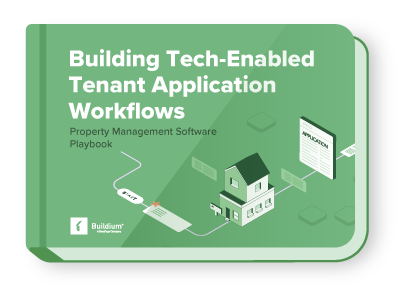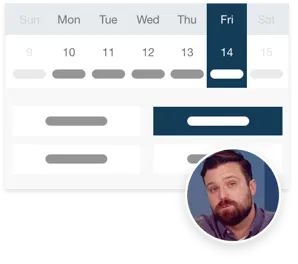Getting a new property management company off the ground can be as exciting as it is challenging, and doing it right can get you a head start over the competition.
Start your free trial today!
Try Buildium for free for 14 days. No credit card needed.
Start Your TrialBut, once you’ve started your company, what comes next?
To answer that question, we spoke with Kelli Segretto, Founder and CEO of K Segretto Consulting, to get her tips on how to build a sturdy foundation that keeps your business profitable and easier to manage. Her advice draws on more than 20 years of experience helping both new and experienced property managers run their companies more effectively.
Read on to for practical steps and strategic advice to help with each area of your business, including:
- How to lay a solid foundation with your operations
- How to set up the right documentation and recordkeeping procedures
- Tips for finding and building strong relationships with clients
- Compliance and legal consideration you should keep front of mind
- Processes to help with managing maintenance and vendors
- Principles to keep your leasing process fair and more manageable
- How to plan for growth and hire strategically
Operations: Build Your Foundation
Your operations are the constantly moving gears that keep your property management company running day to day. Setting up an organized framework from the outset saves you countless headaches as your business grows.
According to Segretto, the first 6 to 12 months are a testing ground where organization is your greatest ally. “If you can have a property management software that is going to hold all of your contacts and allow you to keep straight these properties that you’re bringing in and effectively manage them, that’s probably the most important [factor], not only in the first 6 to 12 months, but throughout the lifecycle of a property management business,” she advises.
Choose a comprehensive platform that helps you track properties, clients, leases, and financials in one place. Reliable software minimizes lost paperwork, reduces errors, and, most importantly, connects your systems together so you can access important information instantly and see its impact across your business.
Setting up the right software early can cut down on your workload, letting you focus on building relationships and making bigger-picture business decisions.
Documentation and Recordkeeping: Create a Repository You Can Rely On
Segretto recommends structuring your digital file storage in a logical, easy-to-navigate way.
“Whether you’re a Microsoft shop or a Google shop, or you prefer Box or Dropbox or any of those storage systems, create a system that works for you where things are easy to navigate, easy to find, and are logically based,” Segretto says.
Replicate the folders you would have in a physical file cabinet: one for leases, one for addenda, one for agreements, and so on. Review your system and update your processes as your business evolves.
Document organization is one of the main ways to stay legally compliant, efficient, and professional, especially as your operations get more complex. Segretto lists some of the most important to keep on hand from Day 1:
- Property management agreements
- Lease agreements
- Addendums
- Policies and procedures manuals
- Employee handbooks
- Owner’s manuals
- Resident manuals
Everything you do should tie back to your core agreements and your policies and procedures. Make it a habit to review your documents at least annually. Laws and best practices change, so an annual review helps you stay current and responsive.
Version control is also your friend here—label and date every version of a document so you can track changes and updates over time.
Client Management: Lay the Groundwork for Lasting Relationships
All the little details involved with onboarding clients (what to communicate, how often, and through which channels) can get complex quickly without a clear process, but Segretto emphasizes the power of checklists:
“Checklists, checklists, checklists,” she says. “Be able to know what documents you need to collect, have efficient ways to collect that information from clients, and understand that most clients are not going to be thorough and detailed and provide everything right out of the gate.”
Develop a step-by-step onboarding checklist for owners. List all the information and documents you need, and include checkpoints to follow up for missing items. Sometimes, you’ll need to pick up the phone to fill in gaps, so don’t rely solely on digital forms.
Set clear expectations for communication at the start. Every client is different—some prefer bullet points, some want every detail, while others just want the highlights. Find out what each owner or tenant prefers, and tailor your updates accordingly.
Segretto recommends asking owners about their preferred communication channel (email, phone, text) and style. Doing this up front helps avoid misunderstandings down the road and builds trust more quickly.
“If you set those expectations early with your owners, they’ll never be disappointed in the way that you communicate with them,” she points out. “They’re not always going to like what you communicate with them, but if you’re meeting them where they’re at, you’ll have better success in building trust in that relationship.”
Pro Tip: An owner portal or similar channel can save you time and even give owners the option to find the details they need in one place, without having to reach out to your team.
Compliance and Legal Considerations: Minimize Risks and Remove Blindspots
Because the legal landscape surrounding property management is so complex, new (and even experienced) business owners almost always lose track of critical regulatory and compliance details. These can range from fair housing laws and ADA regulations to mandatory certifications such as lead-free status for properties.
“There’s a lot of little nuances of regulations that we have to make sure that we are paying attention to and educating ourselves on—it’s really hard to wrap your head around all of it,” she says. “Collect as much as you can and do the best you can. Inevitably [you’ll] make mistakes along the way. Try to jump in, make patches for your mistakes, and put new policies in place that you didn’t know you needed before.”
Be sure to keep all your compliance documents updated, as well. Schedule a calendar reminder once a year to review your agreements, policies, and required certificates. Staying on top of these files reduces the risk of fines and lawsuits and builds a reputation of trustworthiness in your market.
Scaling and Hiring: Build Your Team Intentionally
At some point, growth means you can’t do it all alone. But how do you know when it’s time to hire, and who should fill that first supporting role? Segretto believes it starts by understanding your cash flow and personal strengths.
Your finances are the first factor that determines when you can start hiring and for how specific a role. Some property managers launch with enough capital to hire help right away with a specific task while others wear every hat until growing revenue allows them to add another person to payroll.
Once you’ve determined a realistic timeline for hiring, take a close look at your strong and weak spots to know what kind of talent to bring in.
“We’re normally looking at what are the strengths of the individual who’s running the business,” Segretto says. “Are they a great salesperson? Do they struggle with sales? That’s going to be the determining factor of, am I hiring a business development manager to start churning and pulling in business for us? Or do I need a back office person who can pull together all the documentation and make sure things are running efficiently?”
A practical exercise Segretto recommends is the four-quadrant “Delegate and Elevate” exercise that’s a part of the Entrepreneurial Operating System (EOS). In a nutshell, you identify where you need support by listing out:
- what you’re good at and enjoy
- what you’re good at but dislike
- what you’re not good at but enjoy
- and what you’re not good at and dislike
This exercise highlights where your next hire will make the biggest impact.
Don’t rush into hiring just for the sake of it. Be thoughtful about who will complement your skill set and help you focus on the parts of property management you’re most passionate about. Segretto points out that the amount of passion and energy owners bring to their work translates to better client service and business growth.
Maintenance and Vendor Management: Create Reliable Partnerships and Processes
Maintenance is one of the most visible aspects of your business for tenants and owners. The process can be chaotic, especially when work orders pile up or requests are vague. Segretto reminds new managers to get all the necessary details before fielding a work order. “A lot of times when you receive a work order, it is not clear what they’re actually asking for. If you make too many assumptions, you’ll end up sending out the wrong person to handle the job.”
When an incomplete request comes in, ask follow-up questions such as: Where is the leak? Is it causing damage? Is the issue urgent or routine? The more information you gather, the more accurate your response will be and the better you can match the right vendor to the task.
If you’re tight on time, consider a qualified third-party service such as a maintenance contact center, that can respond to tenants 24/7/365, get all the details, and assign out work orders on your behalf.
Vendor relationships matter. Outsourced contractors are often the only people your tenants interact with on your behalf, so choose vendors who reflect your company’s values and professionalism. Segretto’s advice: don’t always pick the cheapest vendor. Instead, look for reliable, independent professionals who deliver quality work, such as a dependable handyman. For specialized tasks—such as plumbing and electrical issues—aim for mid- to high-tier contractors with strong reputations.
To vet vendors, check whether they answer the phone promptly, ask for references, and, if possible, visit their job sites.
Important questions to consider when vetting vendors include:
- Do they clean up after themselves?
- Do they fix problems on the first visit?
- Would you recommend them to work at your own home?
These details signal how well a vendor will serve your clients and tenants.
Another best practice is to create a basic maintenance workflow you can rely on and adapt as needed. For example:
- Receive the work order
- Contact the tenant for details
- Dispatch the right vendor
- Update the tenant on the timing of the work (with additional reminders for repairs that are multi-step or have timelines that are further out)
- Follow up when the job is complete, confirming the issue has been resolved
- Process the vendor invoice
Pro Tip: Property management software with dedicated maintenance tools can help you organize, speed up, and even automate this workflow.
Review your process monthly and tweak it based on what’s working and what’s not. Consistent evaluation helps you meet tenant needs and reduce stress when urgent repairs pop up.
If you want a more detailed, expansive approach to setting up efficient maintenance workflows, we’ve partnered with Segretto on a two-part guide on the topic:
Leasing: Preserve Fairness and Protect Your Business
When it comes to leasing, Segretto identifies two areas where a lot of new property managers struggle: showings and application processing.
These stages are where you’re often at the greatest legal risk and where due diligence is essential. “It’s making sure that you’re treating every single person exactly the same every time,” she says. “That can be really, really hard to do because you’re busy and you’re being pulled in a hundred different directions.”
To keep your approach both consistently fair and manageable, create a structured, repeatable system for both showings and screening applications. Develop standard criteria for evaluating applicants and apply them consistently. Document every showing and interaction to create a record in case questions arise later.
Segretto also recommends investing in ongoing fair housing training for both yourself and your team as it grows. “Understand that a lot of the times when we have fair housing violations, it’s because we were trying to be nice,” she points out. “It’s not because you were intending to hurt somebody’s feelings or intending to discriminate. It’s because you were trying to accommodate somebody and accidentally asked the wrong question or made an assumption about somebody’s situation.”
Getting the right training and sticking to a clearly-defined process can keep you consistent and compliant.
Marketing: Stand Out and Make the Right Connections
Marketing isn’t just about having a flashy website or social media presence. Segretto suggests that proactive outreach and networking pay off more in the early days. “Get your 30-second elevator pitch and attend every local event having to do with real estate so that you become known in your community,” she recommends.
Join industry groups such as NARPAM, IRAM, NAA, or RHA, depending on your niche. Attend local real estate and community events. Drop by real estate offices, insurance agencies, and financial planners to build relationships and spread the word about your business.
These efforts may take a few months to show results, so be patient and persistent. Segretto acknowledges that this kind of proactive, intentional networking can be tiring work, but also stresses that it’s the most effective way you bring in clients when you’re starting out. “It’ll pay dividends throughout the lifespan of your property management company,” she says.
When marketing your company, she also recommends defining what differentiates your brand and leaning into what makes you unique. Your background, personality, and interests can attract clients who value what you offer. Maybe you’re passionate about sustainability, or you have a knack for technology solutions. Authenticity and enthusiasm attract clients who will appreciate your approach.
“If you’re passionate about what you’re doing, you’re going to make more connections and you’re going to create those community-building opportunities to [the point] where people know your name and are thinking about you and have a positive feeling when they think about you,” she says. “Don’t be afraid to lean into the weird.”
Ready to Take the Next Step?
How you approach your first 6 to 12 months as a property management business owner lays the groundwork for everything that follows. Keep the tips we’ve covered in mind to strengthen each part of your business.
Key Takeaways:
- Focus on organized and clearly defined operations.
- Keep your documents and processes organized and up to date.
- Nurture client relationships with clear communication expectations.
- Stay current on compliance and local regulations.
- Build a reliable team based on your own strengths and weak spots,
- Partner with trustworthy vendors and set up a reliable maintenance workflow.
- Continually educate yourself on fair leasing practices and put the right guiderails in place.
- Get active in your community and lean into the qualities that set you apart.
These habits will help you better manage your business and score some early wins without overlooking the common issues that stifle growth for many property managers.
If you’re looking for a comprehensive property management platform to help you stay organized and confident as you build your company, try Buildium for free with a no-risk, 14-day trial or guided demo.
Read more on Growth




